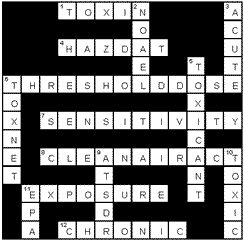Answer Key
Module I Test Your Knowledge Quiz Answers
1. Which of these groups is usually designated as one of the most sensitive sub-populations for exposures to toxic substances?
a. Adult women
b. Infants
c. Adult men
d. Adolescents
2. You have worked at a chemical facility for 10 years. The facility does not require protective equipment, and you have developed a number of serious health effects in the last 7 years. You are possibly experiencing what type of exposure?
a. Chronic
b. Acute
3. You are worried about contamination of vegetables grown in contaminated soils. What type of toxicologist would you contact?
a. Descriptive
b. Environmental
c. Regulatory
d. Food
4. You are concerned about the risks associated with growing vegetables in soil with naturally high lead and arsenic concentrations. You are speaking of what type of substance?
a. Toxin
b. Toxicant
5. The larger the amount of exposure and the greater the dose, the greater the observed response, or effect.
a. True
b. False
6. What type of toxicologist takes samples of blood, urine or hair for testing?
a. Descriptive
b. Analytical
c. Mechanistic
d. Forensic
7. Toxic agents can be classified in terms of their physical state, their effects, and their source.
a. True
b. False
8. Which agency deals with the health effects that may occur from environmental exposure to toxic chemicals?
a. The Environmental Protection Agency
b. The Centers for Disease Control and Prevention
c. The Agency for Toxic Substances and Disease Registry
d. The Nuclear Regulatory Commission
9. Which database has information on emergency handling procedures, environmental data, regulatory status and human exposure?
a. TOXNET
b. HazDat
c. IRIS
d. MEDTREC
10. HazDat contains information on hazardous substances found at NPL and non-NPL waste sites, and on emergency events.
a. True
b. False
11. The no observed adverse effect level (NOAEL) is also known as the no effect level (NEL).
a. True
b. False
12. The term toxicant is used when talking about toxic substances that are produced by or are a by-product of human-made activities.
a. True
b. False
Module I - Toxicology Puzzle Solution

Module II - Routes of Exposure Word Scramble and Matching Solution
Word Scramble
(1) skin
(2) intestine
(3) nose
(4) eye
(5) mouth
(6) ambient
(7) macrophages
(8) environment
(9) biological
(10) gaseous
(11) soil
(12) air
(13) water
(14) food
(15) dermis
(16) inhalation
(17) route
(18) media
(19) groundwater
(20) food chain
QUICK MATCHING
Match the routes of exposure with the correct way for the hazard to enter the body.
A. Absorption
B. Ingestion
C. Inhalation
_A_ Skin
_A_ Eye
_B_ Mouth
_B_ Intestine
Module III - Risk Assessment Test Your Knowledge Quiz Answers
1. Which of the following is NOT a step in the Risk Assessment Process?
a. Hazard identification
b. Hazard evaluation or dose-response assessment
c. Exposure dose
d. Risk characterization
2. Epidemiology is the study of causative factors associated with the occurrence and number of cases of disease and illness in a specific population.
a. True
b. False
3. Exposure tells the toxicologist what dose causes a "response" usually illness or death, in the test animal.
a. True
b. False
4. What activities should be conducted during the hazard identification step of the risk assessment?
a. Identifying the substance name
b. Describing the physical/chemical properties of the toxic substances
c. Identifying the sources of toxicity information
d. Identifying the exposure pathway
e. All of the above
5. Prospective epidemiological studies gather information from the past.
a. True
b. False
6. The exposure assessment step in the risk assessment process identifies all EXCEPT which of the following?
a. Frequency of exposure
b. Type of chemical exposure
c. Length of time of exposure
d. Route of exposure
e. Calculation of the amount of exposure
7. Susceptible populations that may be more at risk for illness than others includes the following EXCEPT:
a. Young children
b. Older adults
c. Teenagers
d. Women of Childbearing Age
Module IV - Survey of Toxic Substances Test Your Knowledge Quiz Answers
1. What are some effects from arsenic exposure?
Death, fever, anorexia, and liver enlargement are some of the effects listed in the module.
2. What form of mercury is the most toxic?
Methyl mercury is the most toxic form of mercury.
3. List some solvents you may use in the home.
Participant answers
4. List the different classes of pesticides.
Insecticides, Herbicides, Fungicides, Fumigants, Rodenticides
5. How does carbon monoxide affect the body?
Decreases amount of oxygen available to the body. Also causes headache, shortness of breath, nausea, irritability, increased respiration, chest pain, impaired judgement, and fainting.
6. What are some sources of ozone?
Lightning, high voltage electrical equipment, and air- and water-purifying devices are some sources of ozone.
7. List the different outdoor air pollutants discussed in the Module.
Carbon monoxide, Sulfur oxides, Ozone, Nitrogen oxides, Particulates
- Page last reviewed: September 1, 2015
- Page last updated: September 9, 2009
- Content source:



 ShareCompartir
ShareCompartir